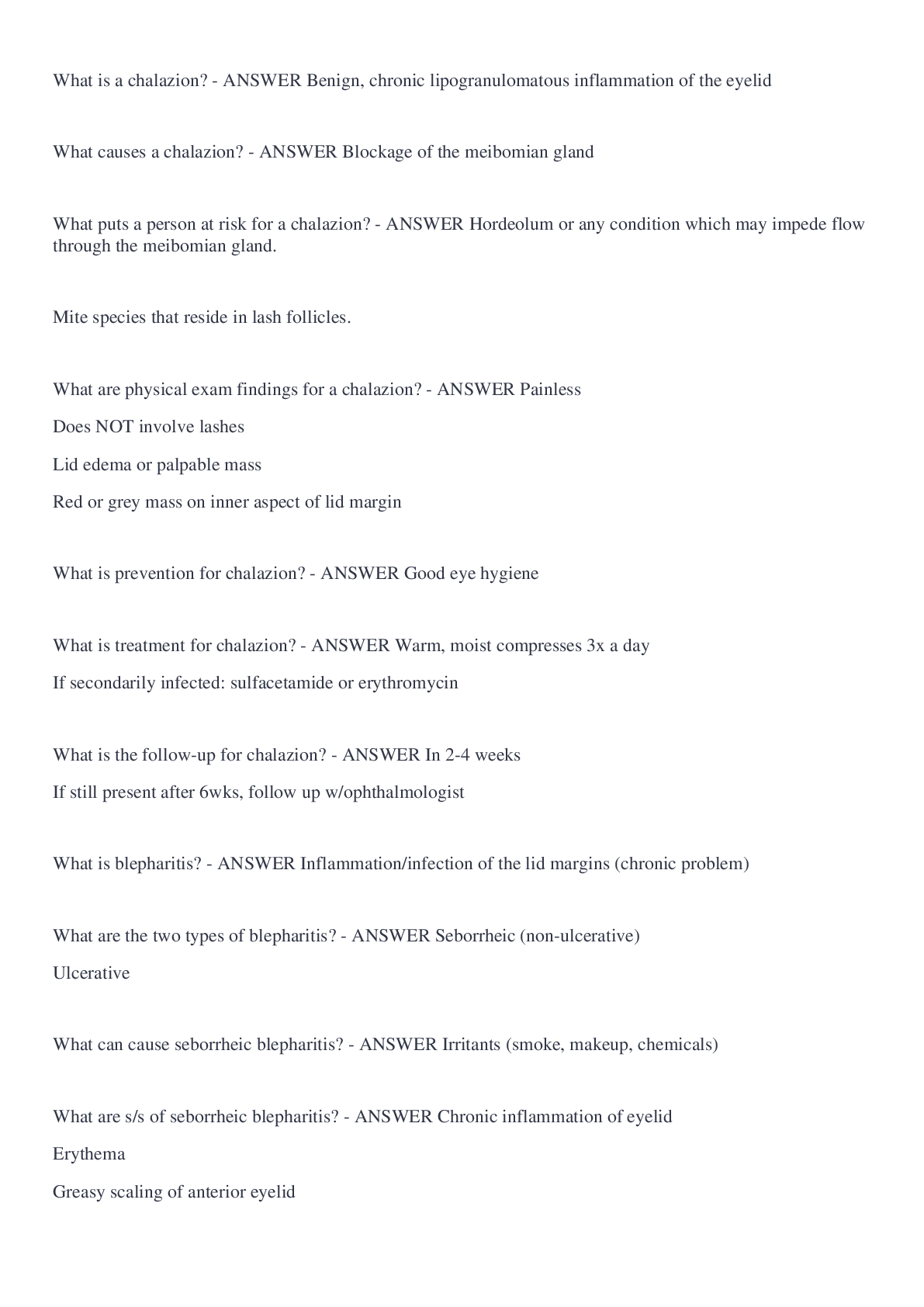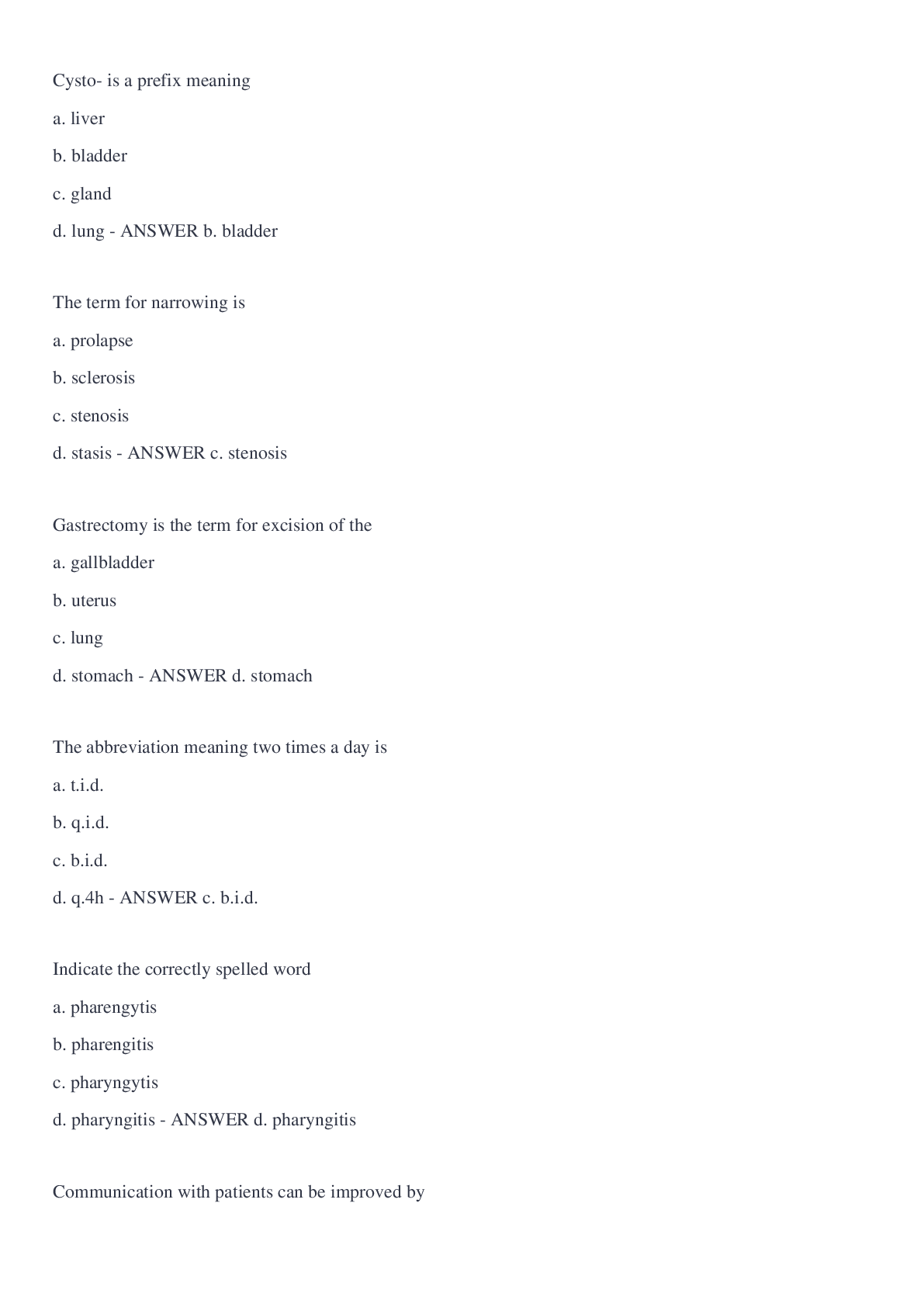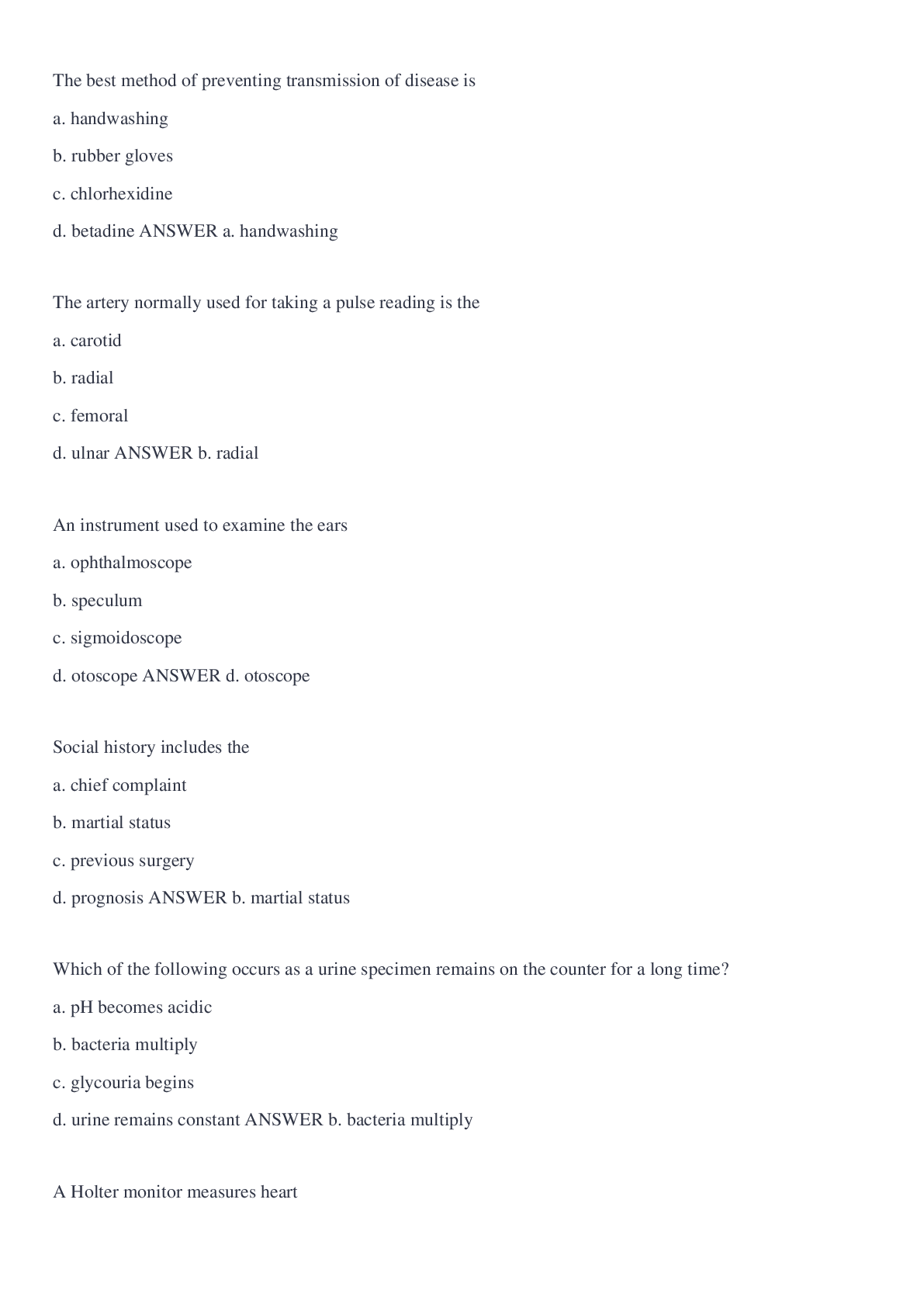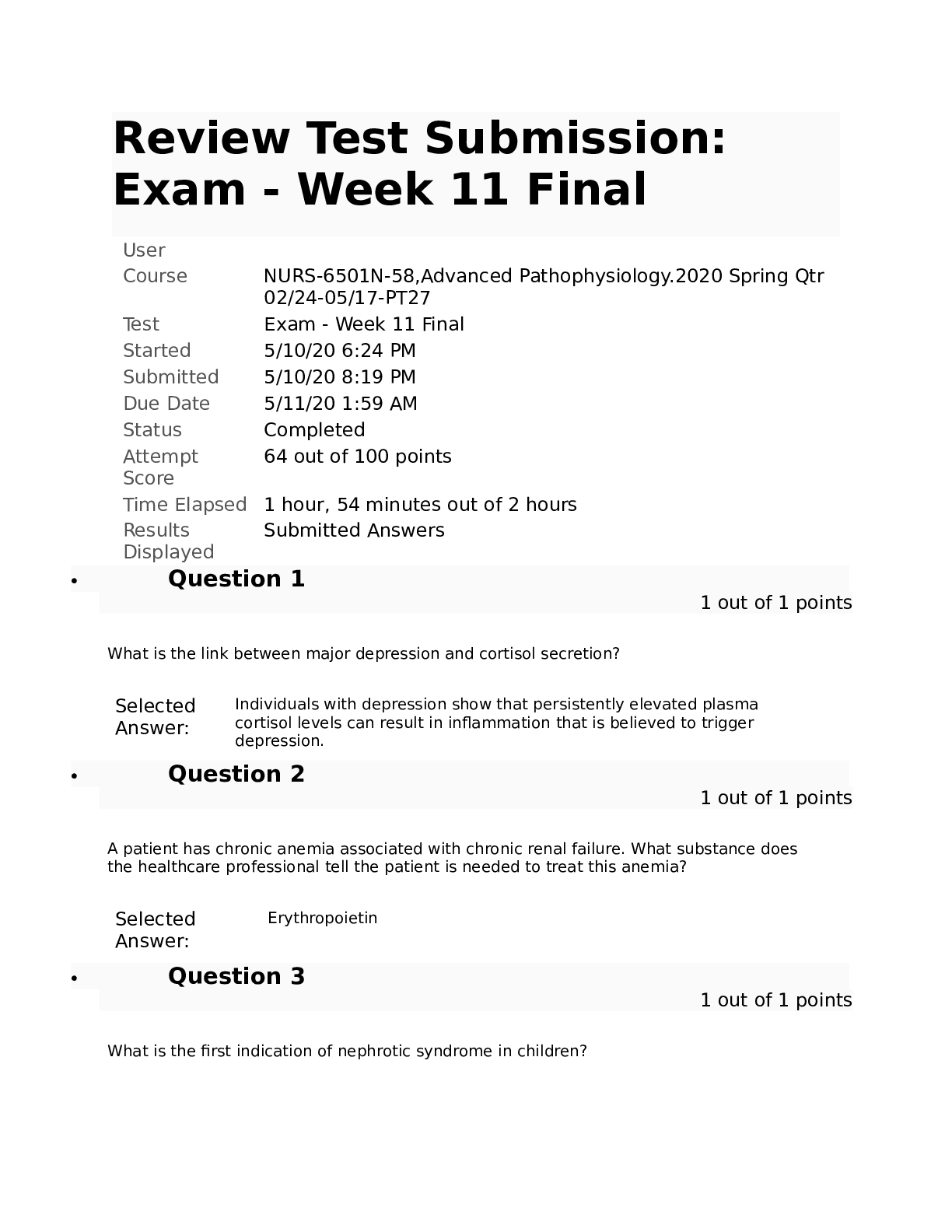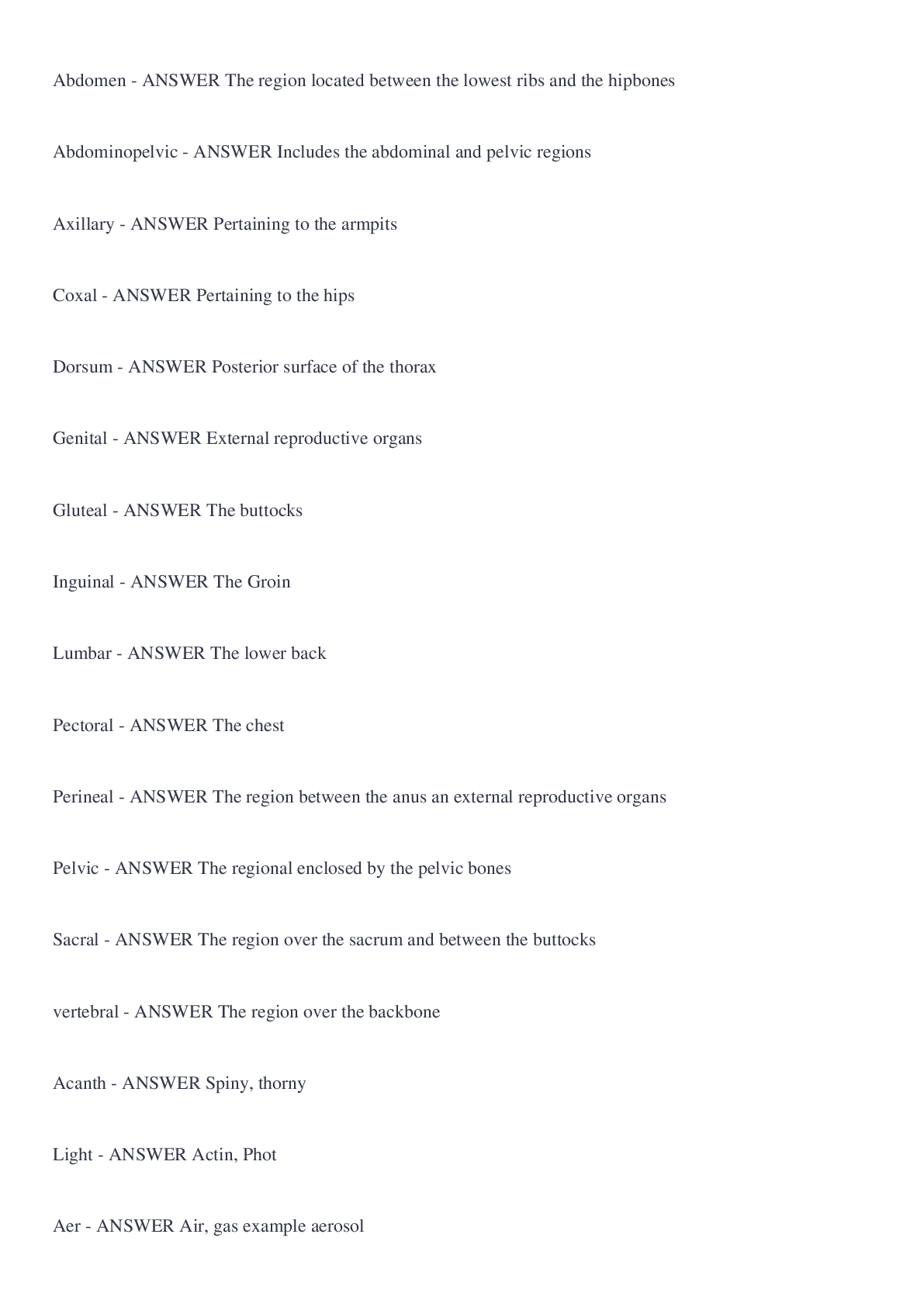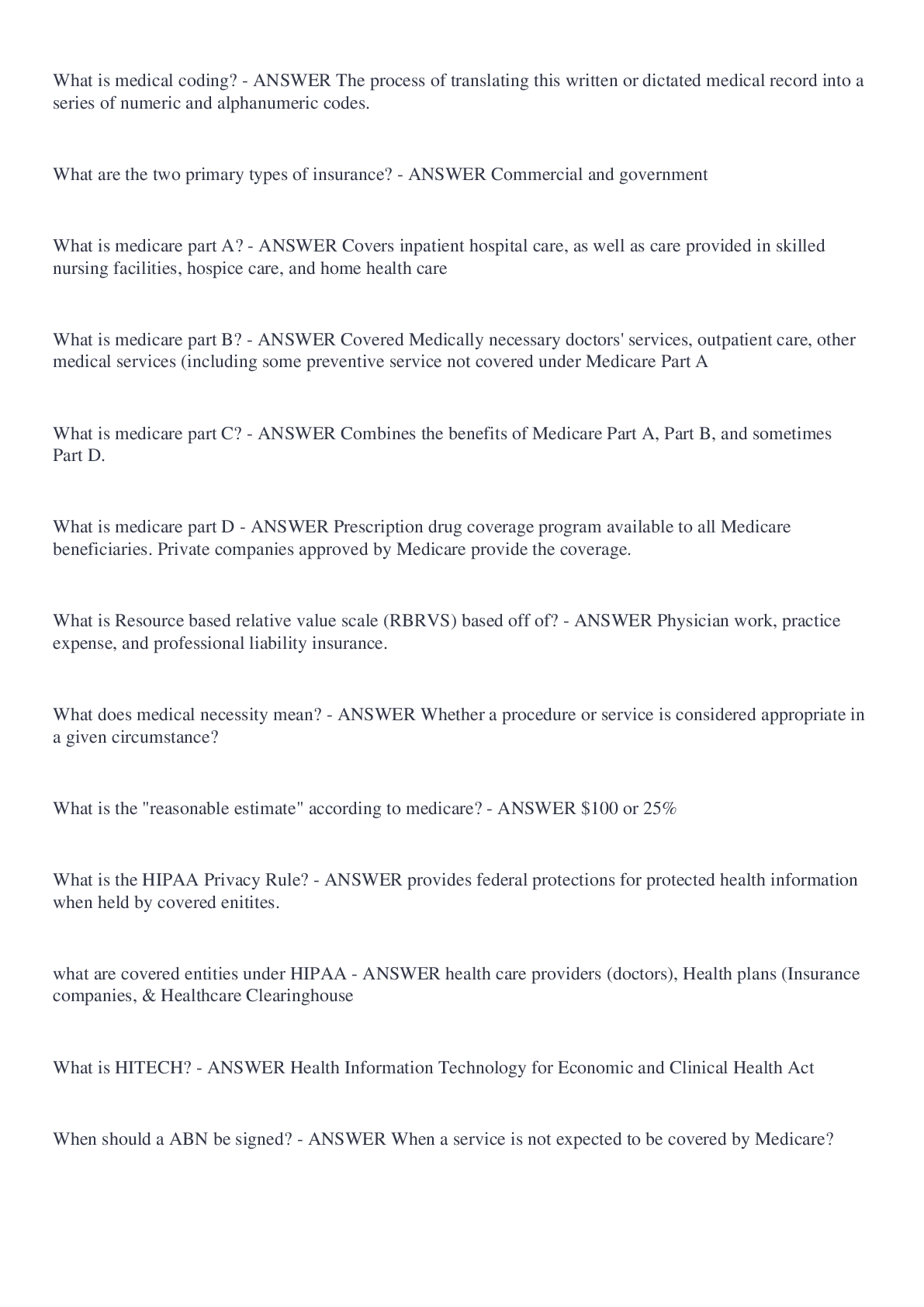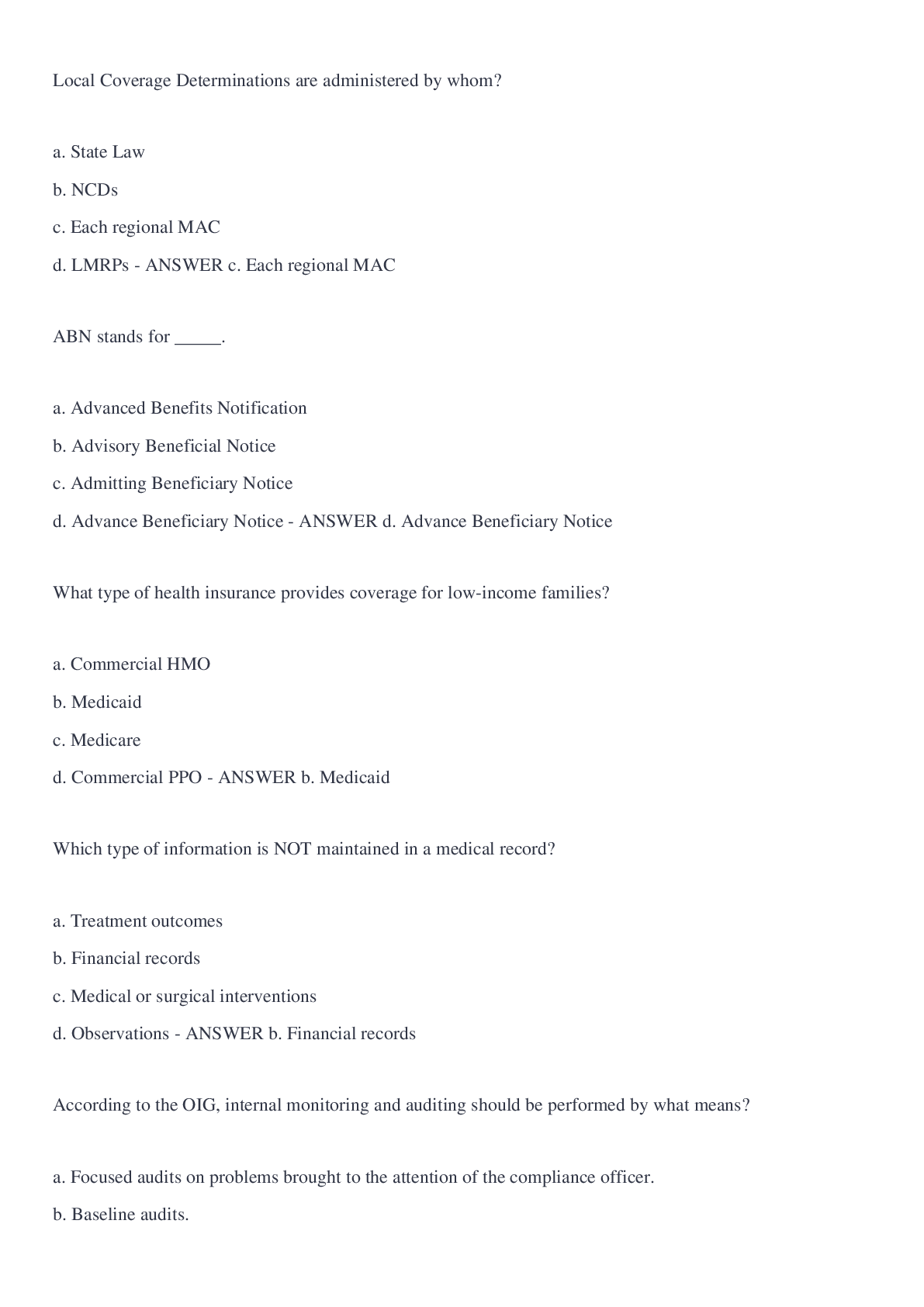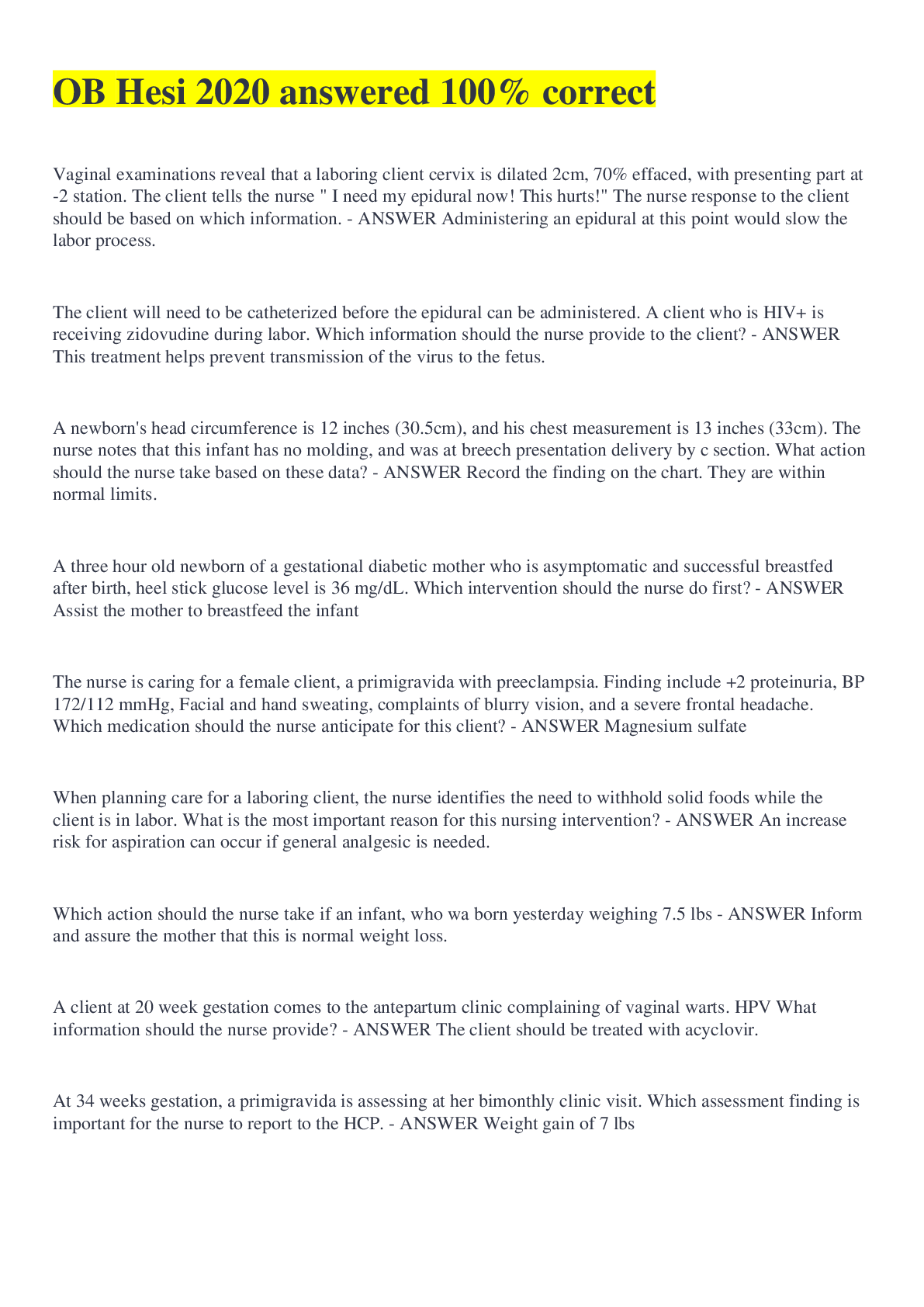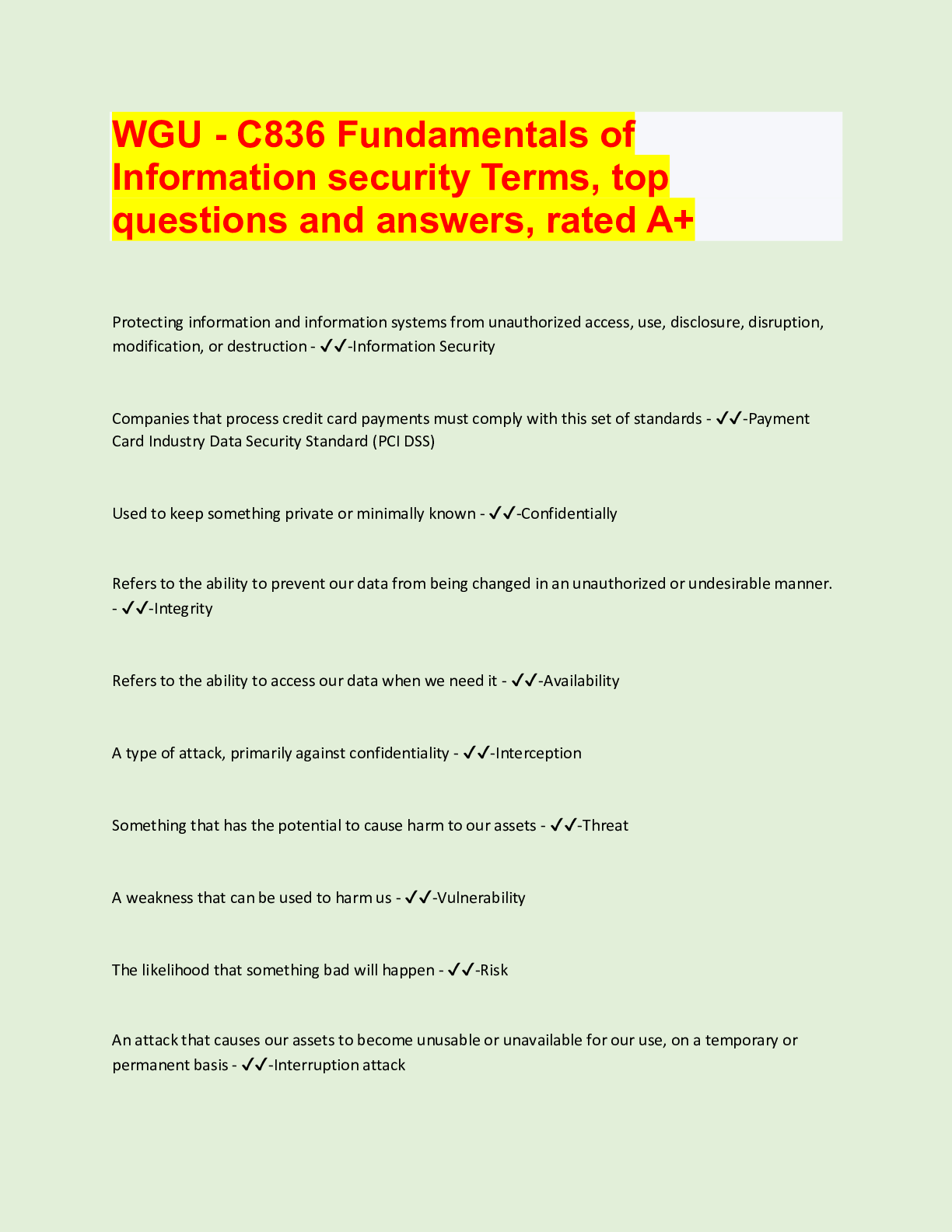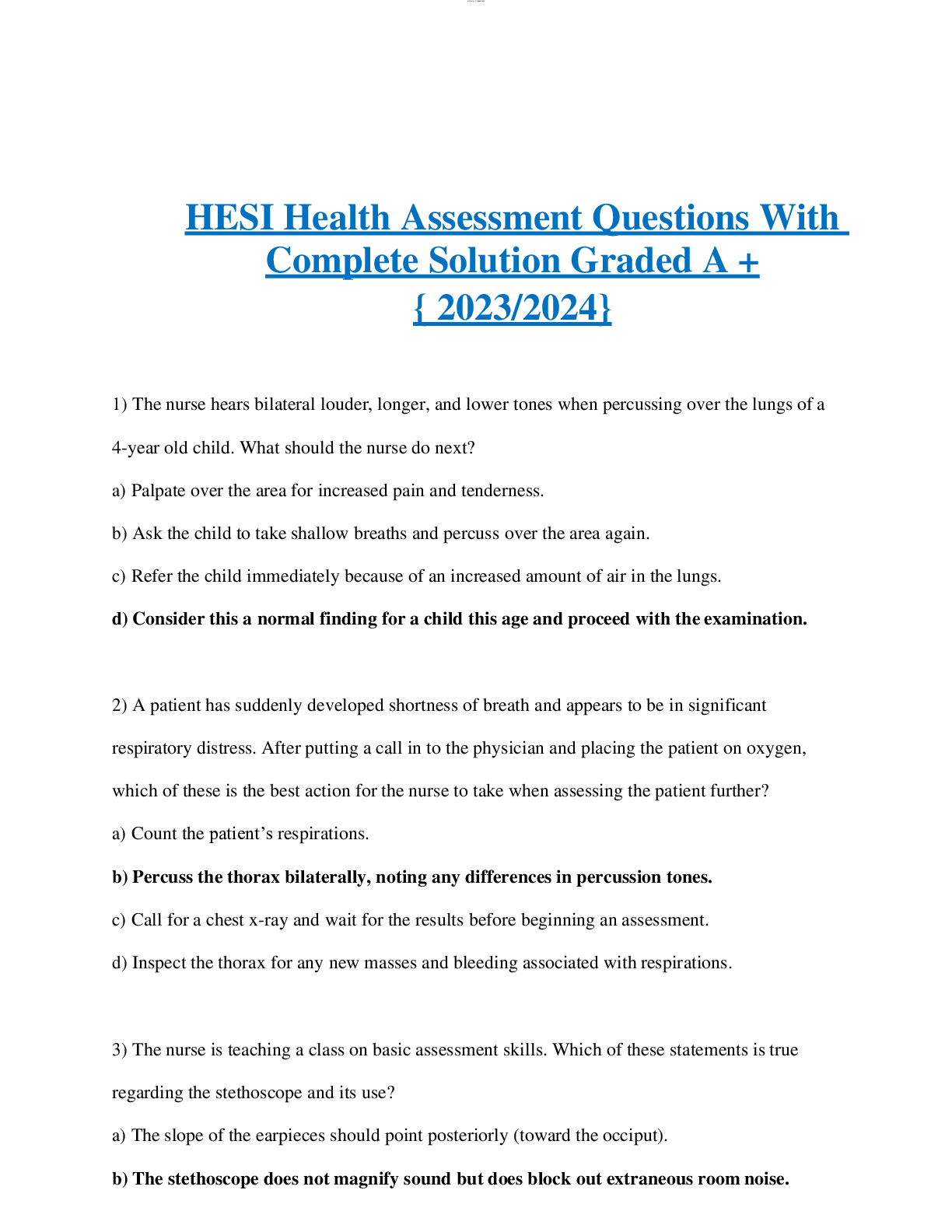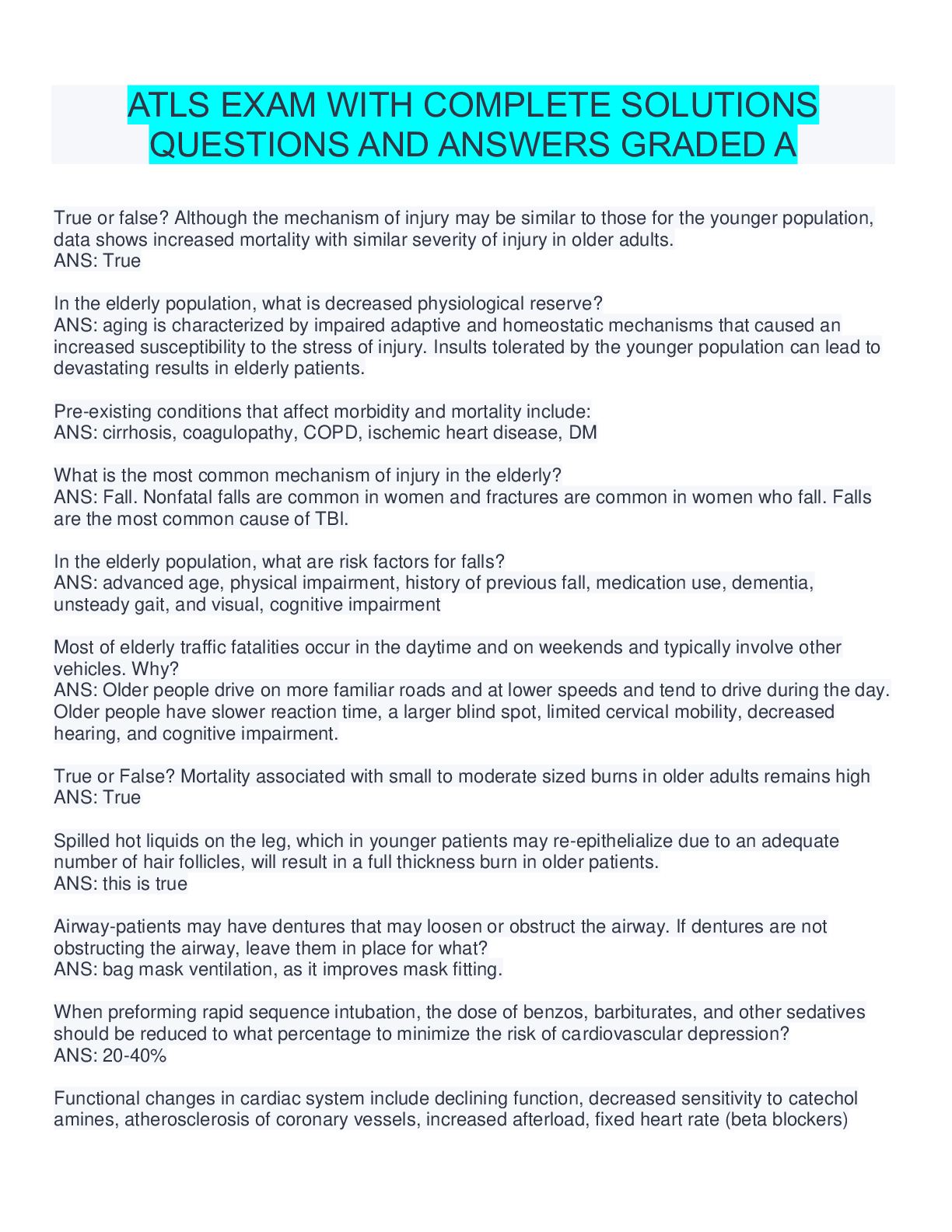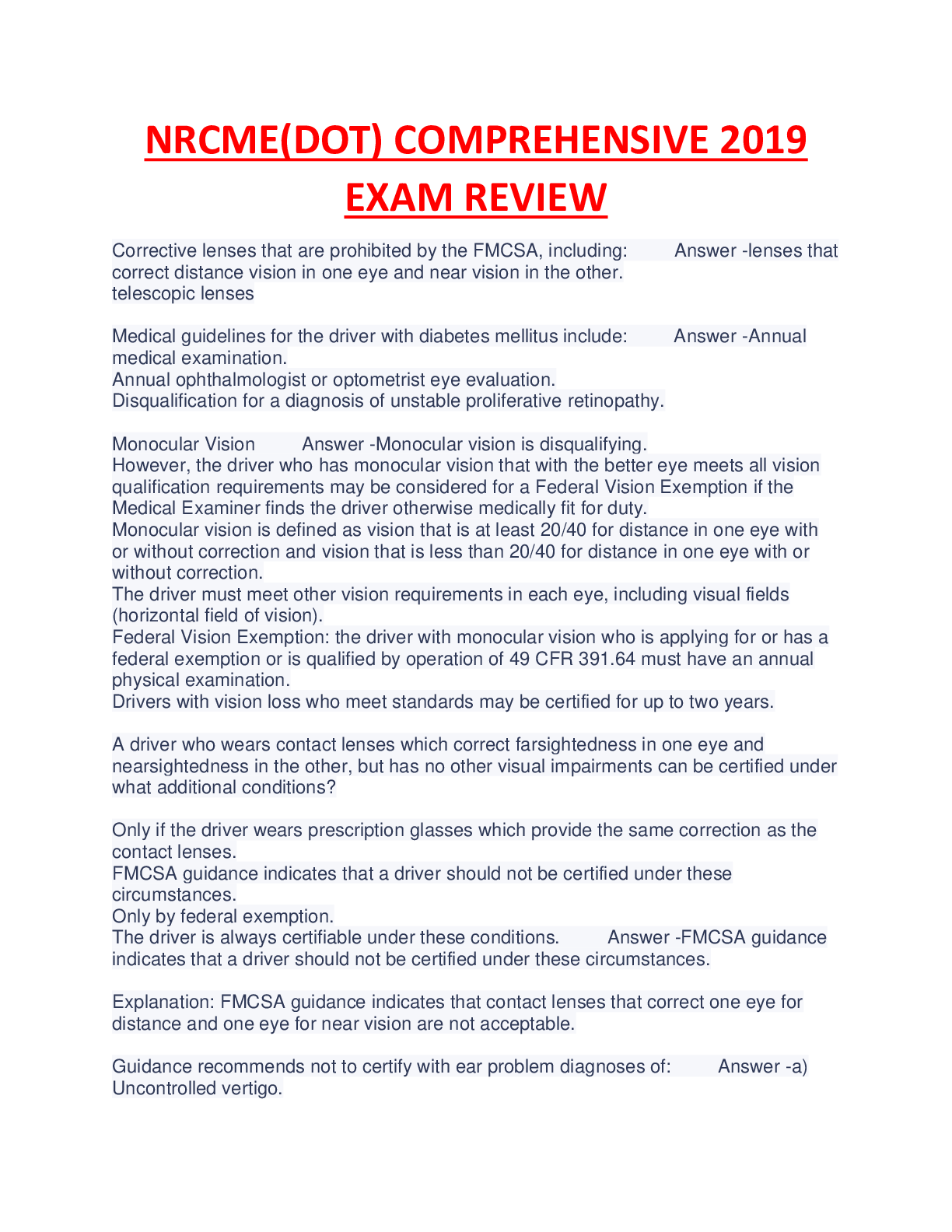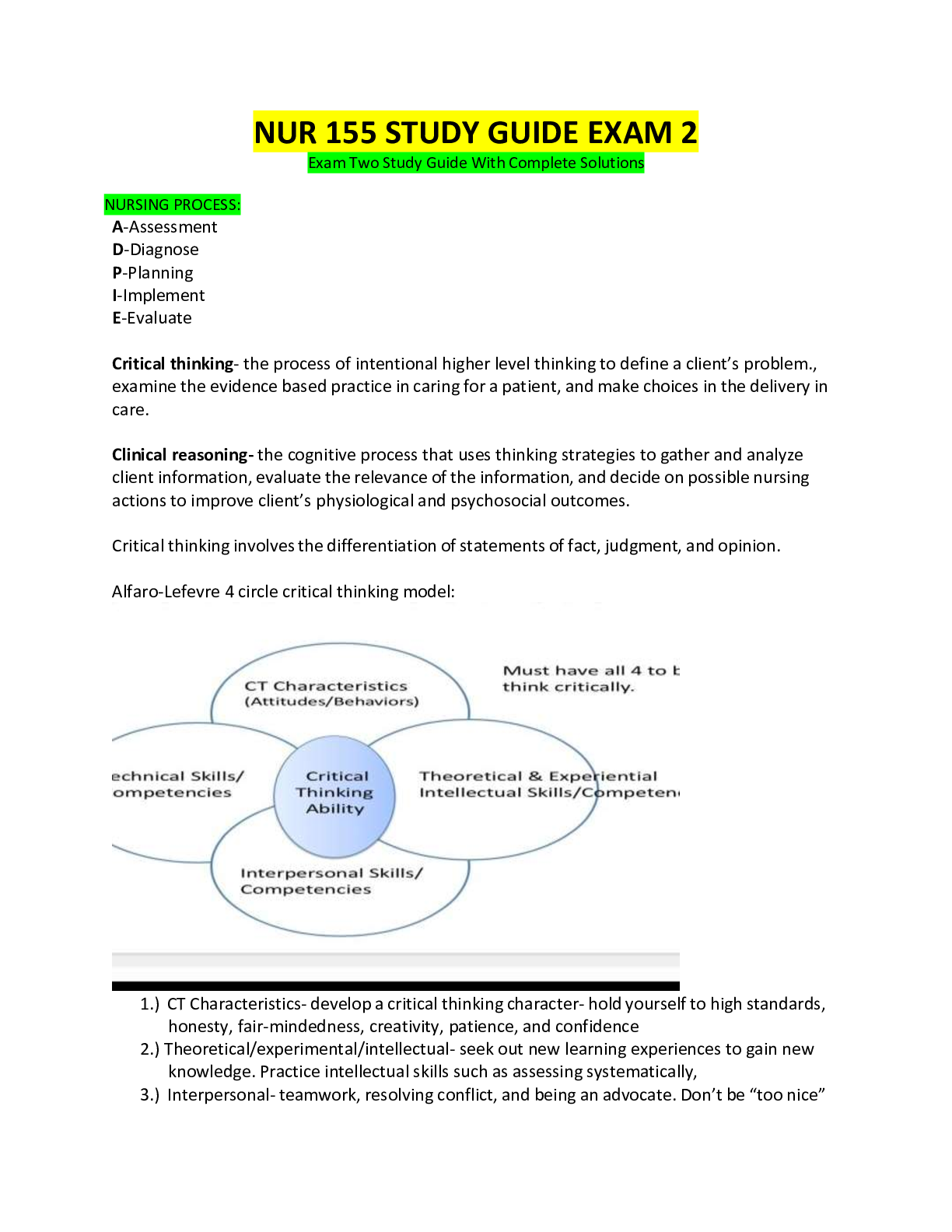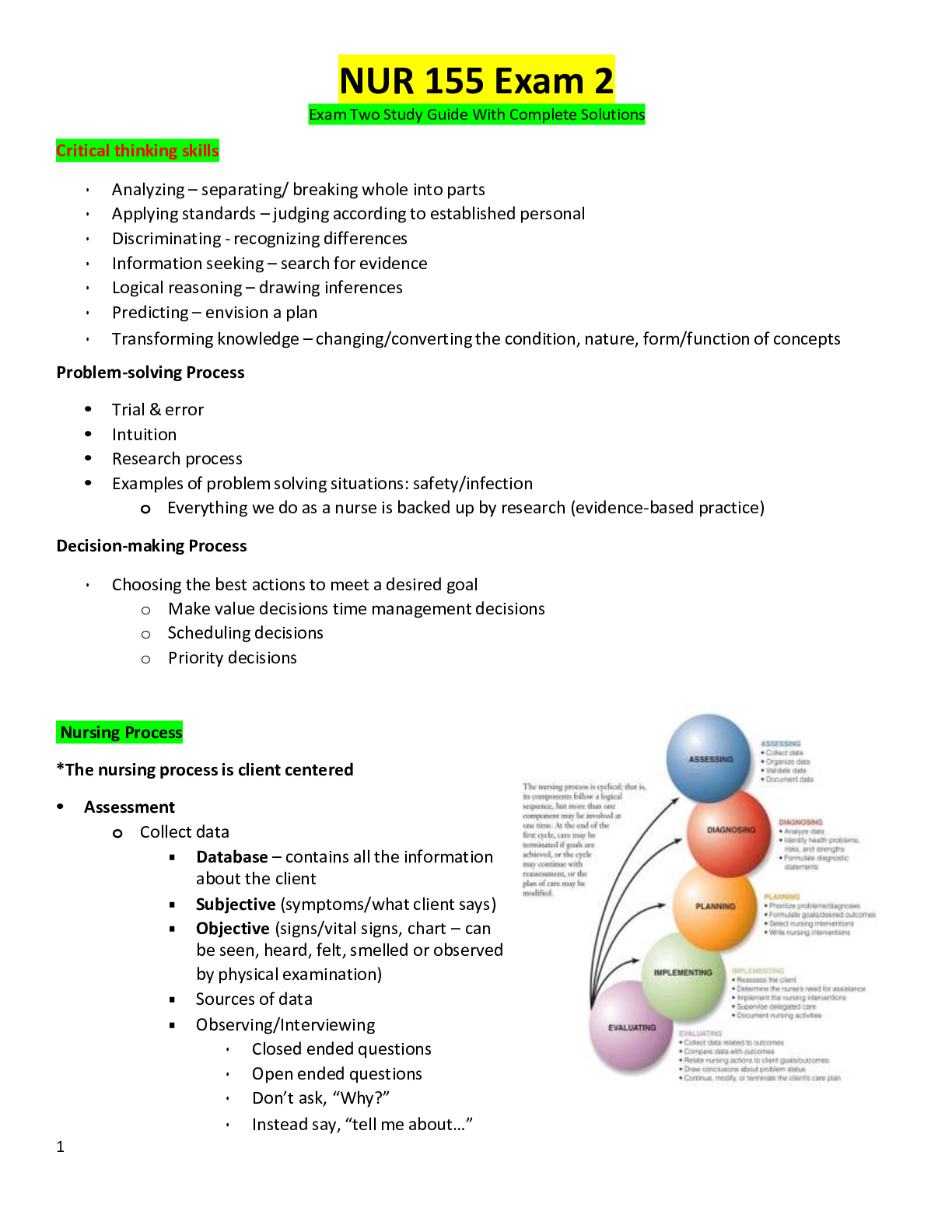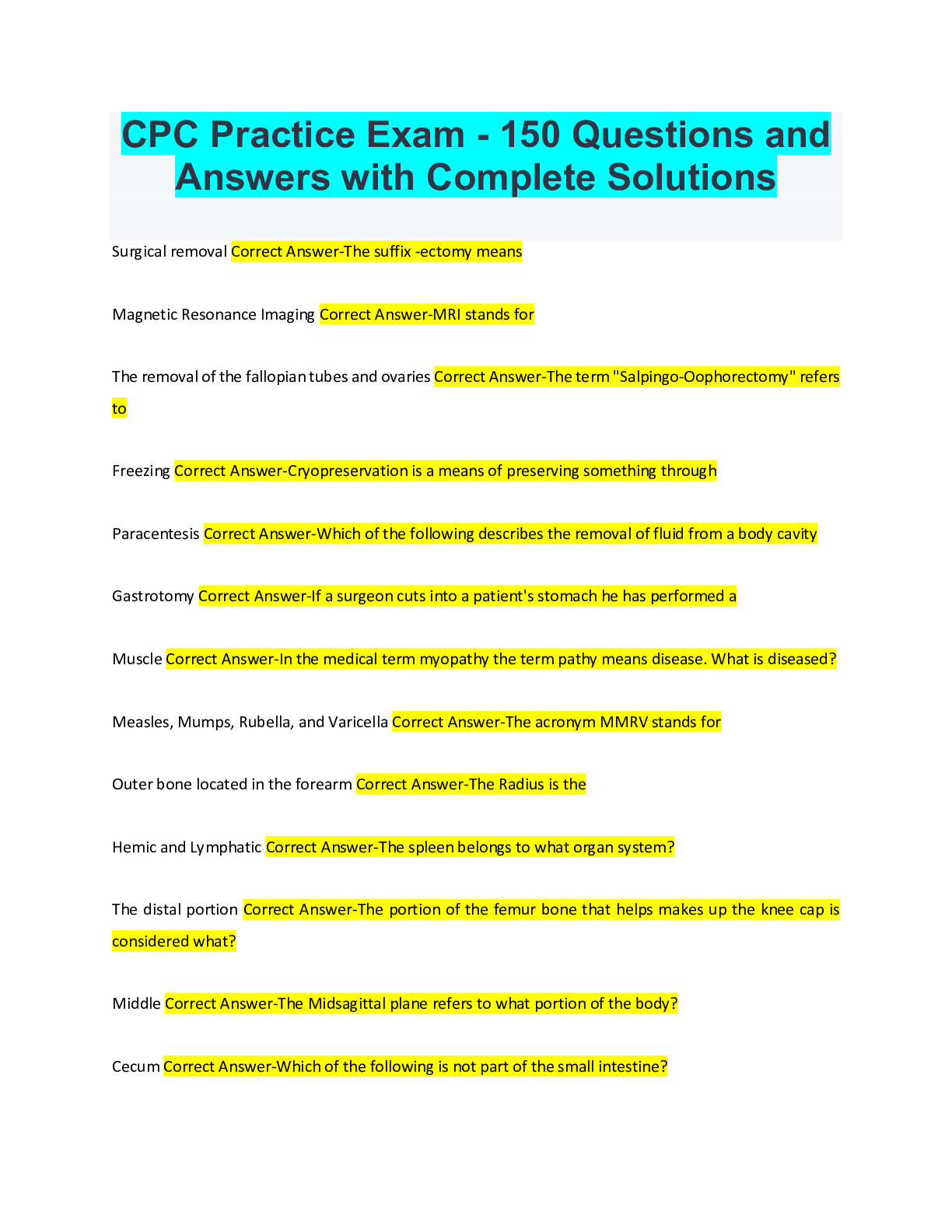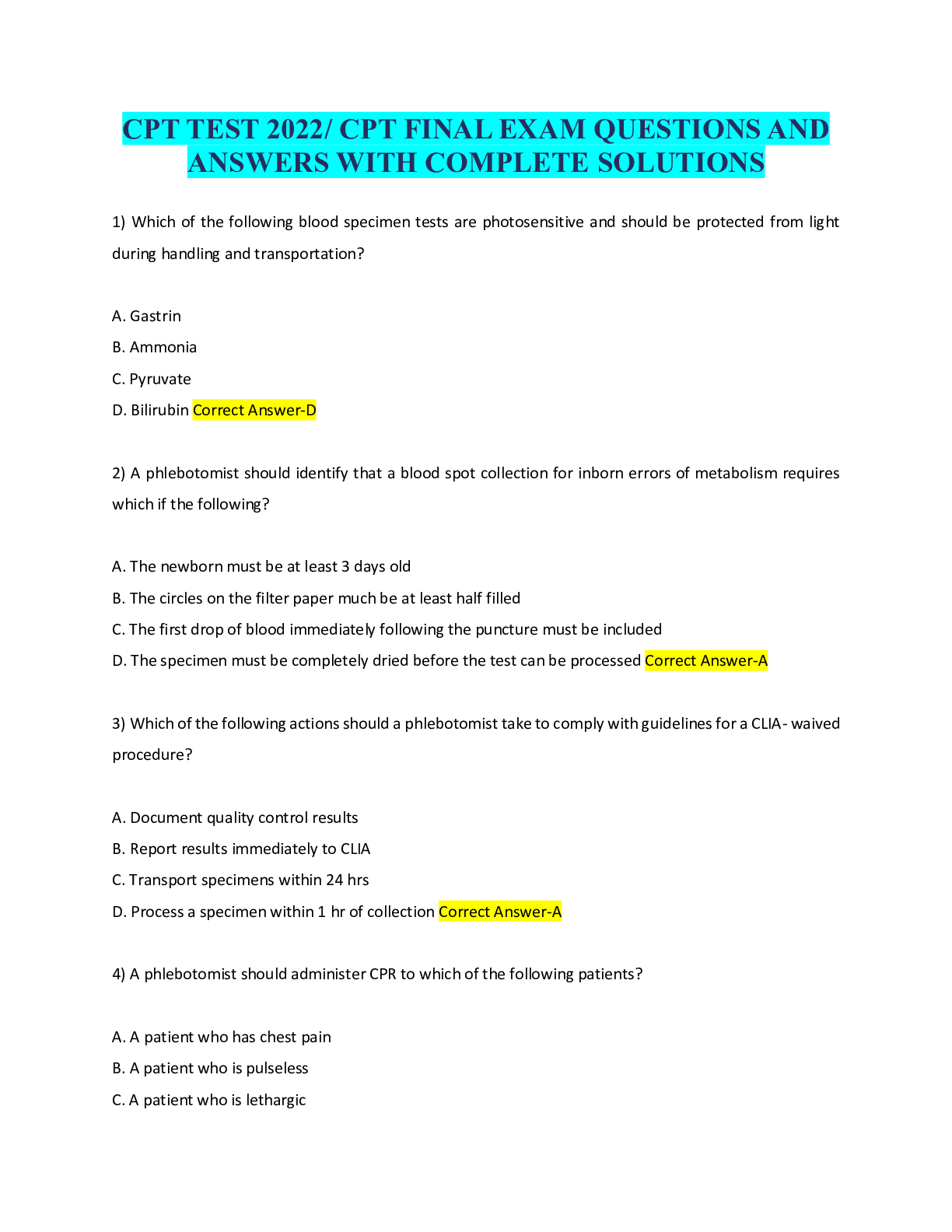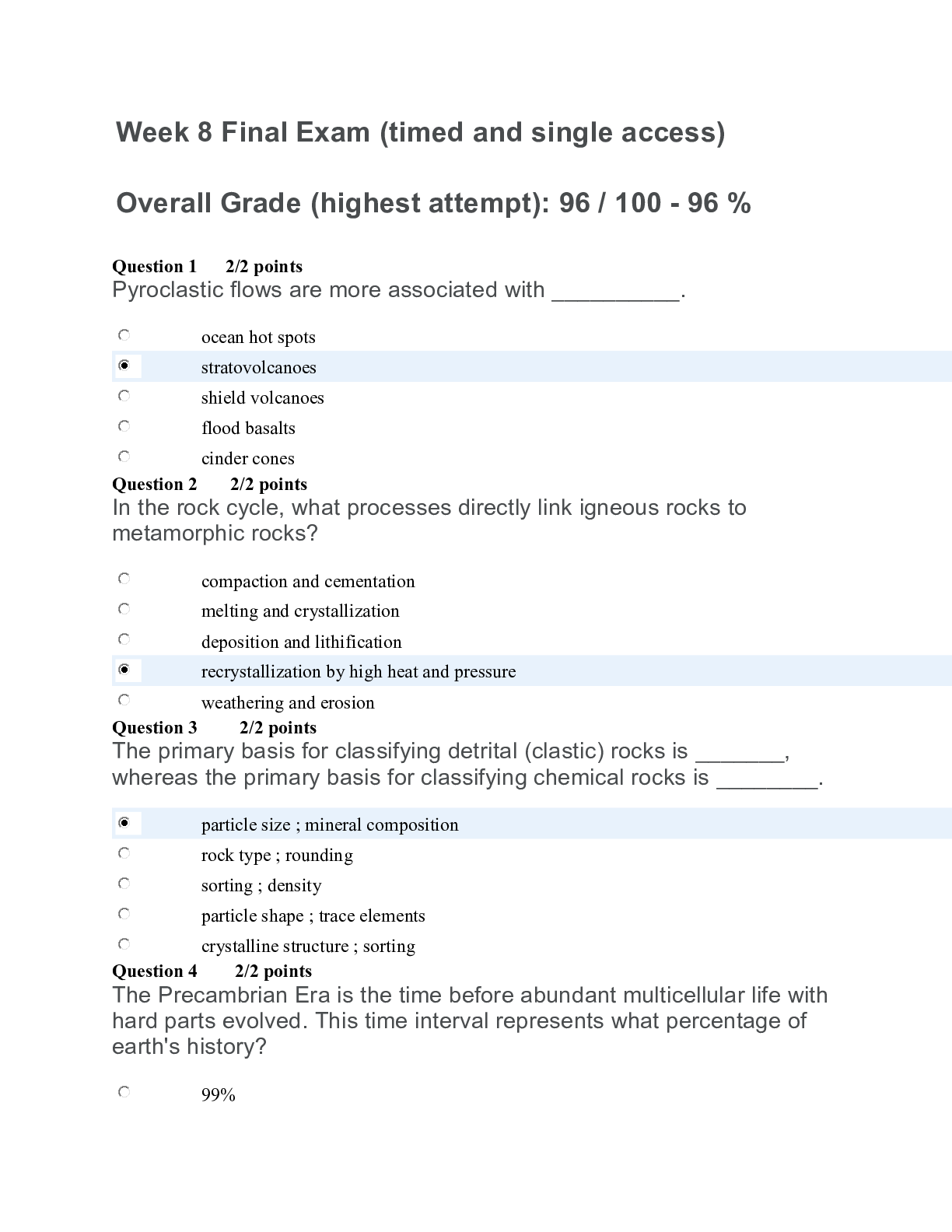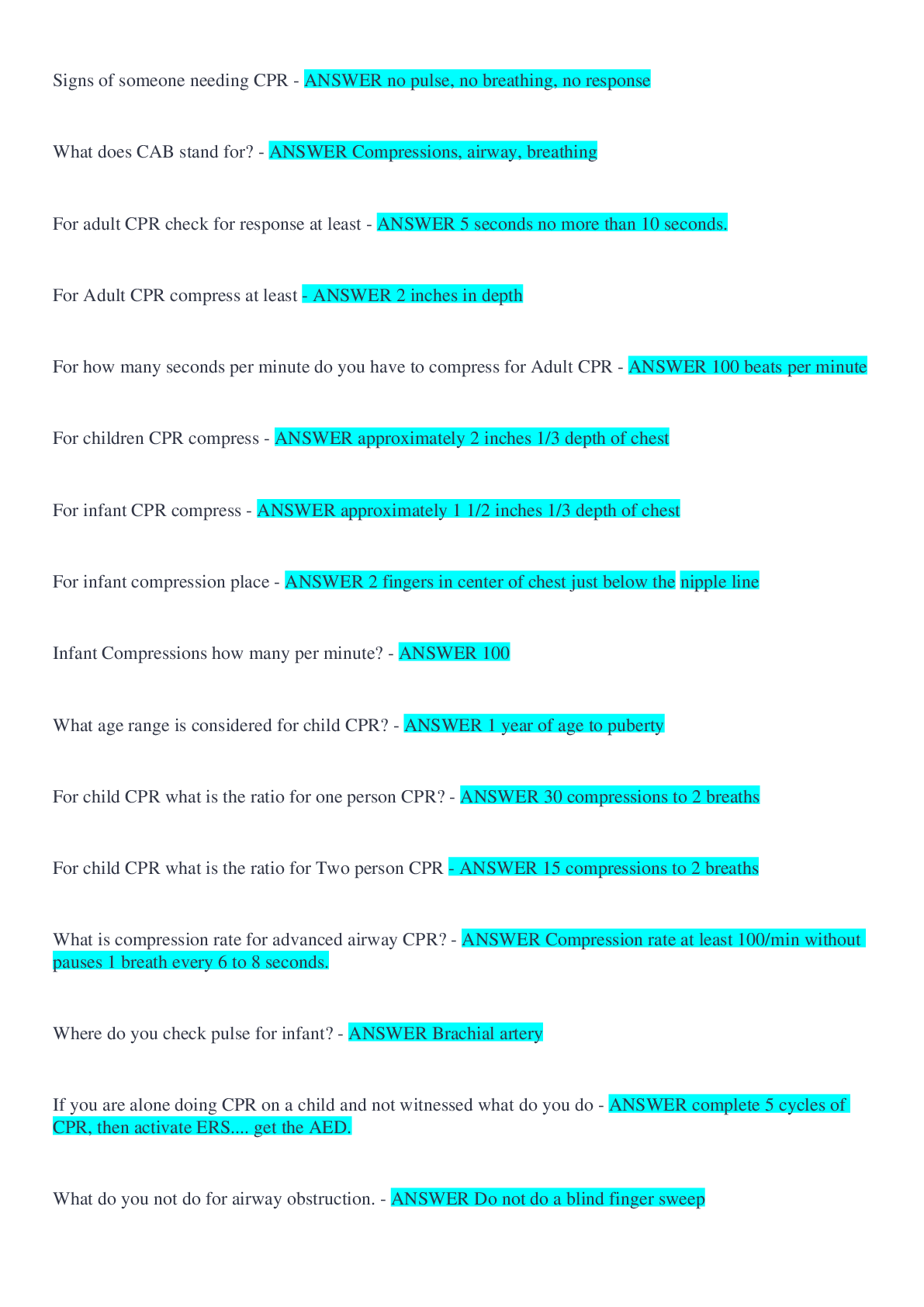ATI OB remediation Exam 2022 with complete solutions
Document Content and Description Below
Newborn Assessment: Manifestations requiring further assessment - ANSWER - Respiratory: periods of apnea >15 seconds, crackles/wheezing (fluid/lung infection), grunting, nasal flaring - Jaundice appe... aring after 24 hrs. (treatment with bili lights) - Head circumference = or >4cm larger than chest circumference --> hydrocephalus; less than or equal to 32 cm --> microcephaly - Bulging fontanels --> increased ICP, infection, hemorrhage; depressed fontanels --> dehydration - Airway obstruction due to mucus --> suction with bulb syringe, gentle percussion over chest to loosen secretion - Hyperthermia/hypothermia (place baby on warmer with no clothes if cold) Safe Medication Administration and Error Reduction: Ensuring proper client identification - ANSWER Must have at least two identifiers before administering medication - can be identified with their full name, date of birth, medical record number, phone number, SSN (cannot use room number). Nursing Care and Discharge Teaching: Evaluating parent understanding about newborn safety - ANSWER nurse should assess family for readiness of home care for the newborn - assess if they have previous newborn experience/knowledge, for parent-newborn attachment, adjustment so far to parental role, social support received, educational needs indicated, sibling rivalry issues, readiness of the parents to have their home/lifestyle altered to accommodate newborn, parents ability to verbalize/demonstrate newborn care following teaching Medical Conditions: Manifestations to Report to the Provider - ANSWER - Cervical insufficiency: premature cervical dilation where expulsion of products of conception can occur (pink stained discharge, gush of fluid or ROM, uterine contractions, increased pelvic pressure, etc.) - Hyperemesis gravidarum: excessive N+V (maybe related to high hCG) prolonged past 12 weeks gestation --> results in 5% weight loss, electrolyte imbalance, acetonuria, ketosis - Anemia: Occurs during pregnancy due to inadequacy of maternal iron stores + consuming insufficient amounts of dietary iron (fatigue, weakness, headache, irritability, dizzy/lightheaded, SOB, palpitations, cravings) - Gestational diabetes mellitus: impaired tolerance to glucose with onset during pregnancy (ideal BG is 70-110 mg/dL) symptoms can disappear a few weeks after delivering (hypoglycemia: nervousness, headache, weakness, irritability, hunger, blurred vision; hyperglycemia: polydispia, polyuria, polyphagia, nausea, abdominal pain, flushed dry skin, fruity breath) - Gestational hypertension: divided into clinical subset (HELLP syndrome). Vasospasm causing poor tissue perfusion is underlying mechanism for pregnancy hypertension. Associated with placental abruption, kidney failure, hepatic rupture, preterm birth, fetal/maternal death. Postpartum Physiological Adaptations: Nursing Action for a Client Who Is Postpartum - ANSWER Important to provide comfort measures during this fourth stage - maternal recovery starts with delivery of placenta and includes first 2 hrs. post birth (parent-NB bonding should occur). Main goal is to avoid postpartum hemorrhage; other goals include assisting in recovery, identifying deviations from expected recovery, pharmacological pain relief, education about NB/self-care, baby friendly activities to promote bonding. Focused PP assessments should be done - breasts, uterus, bowels/GI function, bladder function, lochia, episiotomy, vital signs, pain level and any teaching needs Prenatal Care: Evaluating Client Understanding About Physiological Changes Related to Pregnancy - ANSWER Assist client in self-care of discomforts of pregnancy, promoting safe outcomes, and fostering positive feelings - nurses must take culture into consideration. Should assess client's current knowledge, previous pregnancies, and birthing experiences they've had. Fetal Assessment During Labor: Performing Leopold Maneuvers - ANSWER Performing external palpations of the maternal uterus through the abdominal wall to determine: - Number of fetuses - Presenting part, fetal lie, fetal attitude - Degree of descent of the presenting part into the pelvis - Location of the fetus' back to asses for fetal heart tones (Vertex presentation: FHT should be assessed below mother's umbilicus in right or left LQ; breech presentation: FHT assessed above umbilicus in right or left UQ Baby-Friendly Care: Phases of Maternal Behavioral Adjustment - ANSWER Adjustment begins during pregnancy - first 2 to 6 weeks PP, client goes through acquaintance + physical restoration. Maternal identity around 4 months PP (stages can overlap; variable based on mom/baby/environment). Maternal Role Attainment - Dependent: "taking-in phase" first 24-48 hrs, mother focused on meeting personal needs, rely on others, excited/talkative, need to talk about birth with others - Dependent/Independent: "taking-hold phase" begins on day 2/3 (10 days to several weeks), focused on baby care, want to take charge/need others acceptance, learn/practice, dealing with physical/emotional discomforts ("baby blues" may occur) - Interdependent: "letting-go phase" focus is back on family as a unit, resumption of role (intimate partner/individual) Baby-Friendly Care: Promoting Sibling Adaptation to New Baby - ANSWER Siblings may be experiencing temporary parental separation - RN should assess how they feel Positive: interest/concern for NB, increased independence for themselves Adverse: rivalry/jealousy, regression (toileting, sleeping habits, etc.) aggression, attention seeking behavior RN - take child on tour of hospital, encourage parents to let sibling be one of first to see NB, provide gift from "infant" to sibling, quality time with one parent, allow them to help provide for NB care, give preschool-aged child doll to care for Therapeutic Communication: Caring for a Client Following a Perinatal Death - ANSWER One of the most important goals of the nurse is to validate the experience and feelings of the parents by encouraging them to tell their stories and listening with care - nurse should acknowledge the loss with a simple but sincere comment ("I'm sorry"/"I'm sad for you). The nurse should resist the temptation to give advice or to use clichés when offering support to the bereaved (do not want to decrease mothers want to express emotion to you). Nursing Care of Newborns: Minimizing Pain During a Heel Stick - ANSWER Done for blood sample tests - warm the NB heel first to increase circulation. Swaddling baby and holding them upright (maybe against mothers chest) decreases their pain and makes it easier on infant. Client Education and Discharge Teaching: Nonpharmacological Recommendations for a Client Who Has Engorgement - ANSWER Lactating Mothers: empty breasts completely during feeds (pump if one breast isn't emptied). Apply cool compresses after feedings and apply warm compresses or take a warm shower prior to feeding. Non-lactating Mothers: Wear well-fitting bra for first 72 hrs. Avoid stimulation or running warm water over breasts. Apply cold compresses 15 min. on and 45 min. off. Fresh cold cabbage leaves can be placed inside the bra Pain Management: Nonpharmacological Comfort - ANSWER Cognitive: childbirth prep (patterned breathing, relaxation), Doulas, hypnosis, biofeedback Sensory stimulation: aromatherapy, breathing techniques, imagery, music, use of focal points, subdued lighting Cutaneous Stimulation: therapeutic touch/massage, walking, rocking, effleurage, sacral counterpressure, apply heat/cold, TENS therapy, hydrotherapy, acupressure, changing maternal position Contraception: Contraindication for Oral Contraceptive Use - ANSWER Combined Oral: Hx of thromboembolic disorders, stroke, heart attack, coronary artery disease, gallbladder disease, cirrhosis, liver tumor, headaches, uncontrolled hypertension, diabetes mellitus, breast/estrogen-related cancers, pregnancy, lactating, less than 6 wks. PP, smoking Progestin-only: bariatric surgery, lupus, severe cirrhosis, liver tumors, current/past breast cancer Emergency Oral: if client is pregnant or has undiagnosed vaginal bleeding Pain Management: Planning Care for a Client Who Is Receiving Epidural Anesthesia - ANSWER Institute safety precautions (put side rails up, as they may experience dizziness). Assess for nausea, emesis - administer antiemetics as prescribed. Monitor vital signs, monitor for allergic reactions, continue FHR monitoring. Assessment and Management of Newborn Complications: Findings to Report to the Provider - ANSWER Signs of neonatal substance withdrawal, hypoglycemia, respiratory distress/asphyxia/meconium aspiration, preterm NB, small for GA, large for GA, macrosomic NB, postmature NB, NB infection/sepsis, birth trauma or injury, hyperbilirubinemia, congenital anomalies Assessment of Fetal Well-Being: Teaching About a Nonstress Test - ANSWER Most widely used technique for antepartum evaluation of fetal well-being (3rd trimester) External transducers attached to outside of pt. abdomen - client pushes button when fetal movement is felt, this is noted on tracing Client prep: seat client in reclining chair or semi fowlers/left lateral position, apply conduction gel to clients abdomen, apply two belts to clients abdomen, attach FHR and uterine contraction monitors. (if fetus is sleeping, vibroacoustic stimulation used to wake up the fetus) Medical Conditions: 1-Hr Glucose Tolerance Test - ANSWER Glucola-screening test/1-hr glucose tolerance test: 50 g oral glucose load, followed by plasma glucose analysis 1 hr. later performed at 24-28 weeks of gestation (fasting not necessary) a positive blood glucose screening is 130-140 mg/dL or greater (additional testing with 3 hr. oral glucose tolerance test or OGTT is then indicated) Early Onset of Labor: Rupture of Membranes - ANSWER PROM: Premature rupture of membranes - spontaneous rupture of amniotic membranes 1 hr or more prior to the onset of true labor (for most, signifies onset of true labor if gestation at term) PPROM: preterm premature rupture of membranes - premature spontaneous rupture after 20 weeks of gestation and prior to 37 weeks of gestation Assessment and Management of Newborn Complications: Identification of Spina Bifida Occulta - ANSWER Neural tube defect in vertebral arch fails to close - seen as an abnormal tuft of hair, a birthmark or protruding spinal tissue. Medical Conditions: Providing Teaching for a Client Who Has Hyperemesis Gravidarum - ANSWER Advance client to clear liquids after 24 hrs. if no vomiting is occurring; advance clients diet as tolerated, with frequent small meals (start with dry toast, crackers, cereals, etc. then move to soft diet and finally normal diet as tolerated). In severe cases, or if vomiting returns, enteral nutrition by feeding tube or total parenteral nutrition can be considered. Postpartum Infections: Teaching About Clinical Manifestations to Report to the Provider - ANSWER - Puerperal infections: elevated temp of at least 38˚ for 2+ days, tachycardia - Endometritis: uterine tenderness/enlargement, dark/profuse lochia (also malodorous/purulent), temp >38˚ on 3rd-4th day PP, tachycardia - Wound infection: warmth, erythema, tenderness, pain, edema, seropurulent drainage, dehisence, evisceration - Mastitis: axillary adenopathy affected, inflammed - UTI: urinary urgency, frequency, dysuria, discomfort, fever, chills, malaise [Show More]
Last updated: 1 year ago
Preview 1 out of 5 pages
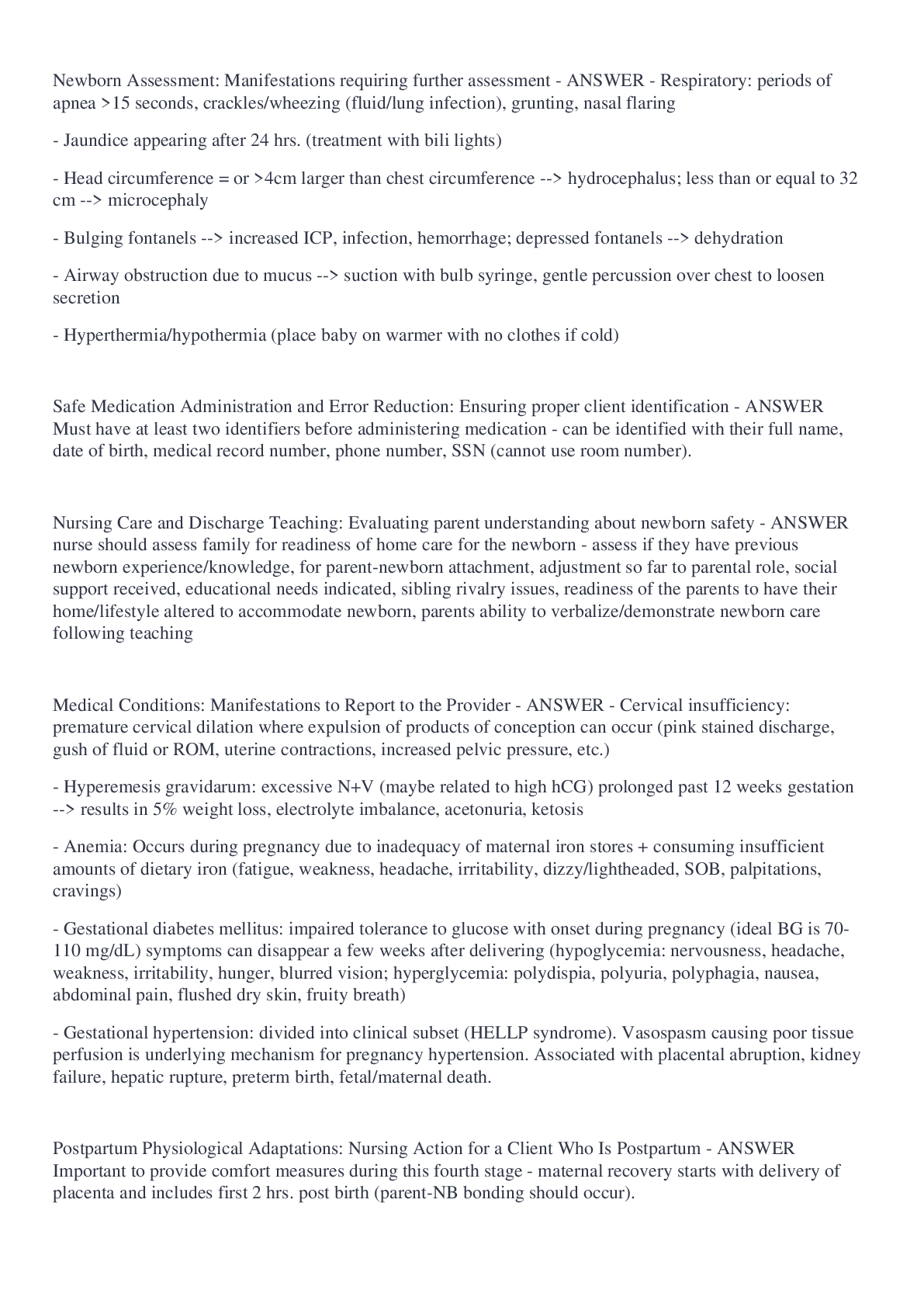
Reviews( 0 )
Document information
Connected school, study & course
About the document
Uploaded On
Jul 24, 2022
Number of pages
5
Written in
Additional information
This document has been written for:
Uploaded
Jul 24, 2022
Downloads
0
Views
42





